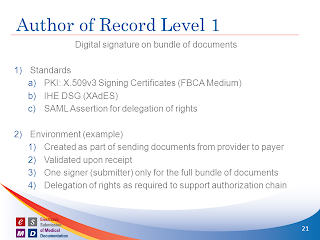Much of the new consensus is to harmonize with other works in progress. Such as the efforts I am driving to define a RESTful equivalent to XDR and XDS with Mobile access to Health Documents (MHD), and updates to the definition of IHE ITI Technical Framework Metadata.
In the ballot are three things. First, a CDA specification that shows how to identify different segmentation within a CDA document, Second, a specification for XDM metadata for use with Direct, Third, a specification for XDR. Yes, this third part is XDR, but it is called XDS-Metadata-Content-Profile because the current IHE Technical Framework Volume 3 section 4.0 is called "XDS Metadata". This is about to change, as IHE is publishing new Technical Framework and Volume 3 section 4.0 is now written more broadly to include XDS, XDR, XDM, XCA, and be ready to for others like MHD.
HL7 Implementation Guide: Data Segmentation for Privacy (DS4P), Release 1
Chapter 1: CDA R2 and Privacy Metadata Content ProfileChapter 2: NwHIN Direct XDM Metadata Content Profile
- HL7_IG_DS4P_R1_CH1_CONTENT_N1_2013SEP.pdf
Chapter 3: NwHIN SOAP/Exchange XDS Metadata Content Profile
- HL7_IG_DS4P_R1_CH2_DIRECT_N1_2013SEP.pdf
Sample Files
- HL7_IG_DS4P_R1_CH3_EXCHANGE_N1_2013SEP.pdf
CDA R2 and Privacy Metadata Content ProfileChapter 2: NwHIN Direct XDM Metadata Content Profile
- SegmentedDocumentContentProfileSample.xml
- SampleXDMetadata.xml
